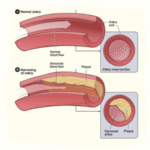The formation of a clot of blood in a vein, artery or the heart, thrombosis is usually caused by damage to the lining of the blood vessel. Other causes are a stagnation of blood and an increased clotting tendency in the blood.
Damage to a blood vessel wall causes the blood platelets to stick together and release prothrombin, a substance which causes strands of fibrin to be laid down; these strands entangle blood cells and a clot or thrombus is formed.
Damage to veins is usually from inflammation (phlebitis); damage to arteries is from atherosclerosis; and damage to the lining of the heart is from a heart attack in which the damage to heart muscle (infarct) extends to the interior of the heart.
The danger of thrombosis lies in its threat to the circulation: a clot may block an artery and cut off the blood supply to tissue such as heart or brain (infarction) or may be detached and swept along in the bloodstream to a distant artery, and block it (embolism).
Thrombosis is a pile, or hemorrhoid, is painful but not dangerous. Thrombosis in a varicose vein may be curative; in the injection treatment of varicose veins, the injected substance irritates the lining of the vein, causing thrombosis and leading to destruction of the unwanted varicose vein. But thrombosis in an artery supplying a vital organ is serious; is serious; a clot in a cerebral artery causes a stroke and one in a coronary artery a heart attack.
Occasionally a heart attack or cardiac infarction is followed by the development of a thrombus on the damaged inner wall of the heart. Such a thrombus may become detached and travel to the brain (an uncommon cause of stroke). If a clot in a deep vein becomes detached, it will be carried to the lungs (pulmonary embolism), causing pain, breathlessness and even death.
Prevention of thrombosis in an artery is based on following measures to avoid atherosclerosis including regular exercise, no smoking, and control of blood pressure and avoidance of obesity.
In women taking the pill, the risk of thrombosis leading to lung embolus is increased about four times. Women that is older than 35 and women smokers older than 30 are at even greater risk and are advised to use another method of contraception.
Prevention of thrombosis after surgical operations has been based for many years on the principle of getting the patient out of bed at an early stage to combat stagnation of blood in the leg veins. Recently it has been shown that the risk of thrombosis is greatly reduced by small injections of the anticoagulant heparin and by intermittent compressions of the calf muscles.
To prevent thrombosis after a heart attack, sulphinpyrazone may be recommended, and for some severe cases, the oral anticoagulant warfarin. This drug is also given together with dipyridamole to patients with artificial heart valves to prevent a clot forming on the foreign implant. Treatment with warfarin, however, requires regular blood tests in order to determine the right dose and the avoidance of drugs which alter its effect. One such drug is aspirin which, by virtue of its mild anticlotting action, finds a place in the prevention of minor strokes (transient cerebral ischemia).
Treatment of thromboembolism is with the rapidly acting heparin, given intravenously for a week or so and followed by warfarin tablets for several months. Other drugs used are those which break down fibrin, the fibrof thromboembolism is with the rapidly acting heparin, given intravenously for a week or so and followed by warfarin tablets for several months. Other drugs used are those which break down fibrin, the fibrinolytic agents such as streptokinase and urokinase; injected into the affected vessel, they may dissolve a fresh thrombus.
Source:
Journal of Thrombosis and Haemostasis
Volume 7, Number 12, December 2006, pp. 102-103
Publisher: Blackwell Publishing



